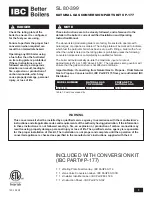
17
PART 4
WATER CONNECTION
∗
Check all applicable local heating, plumbing and building
safety codes before proceeding.
∗
If the appliance is installed above radiation level it must be
provided with a low water cut-off device at the time of
appliance installation (available from factory). Some local
codes require the installation of a low water cut-off on all
systems.
∗
A pressure relief valve is supplied with each
Dynaforce®. The relief valve must be mounted in a
vertical position and piped to the floor in a manner
acceptable to the enforcing authority.
∗
Minimum water operating system pressure should not
drop below 30 PSIG.
∗
Be sure to provide unions and gate valves at inlet and
outlet to the appliance so that it can be easily isolated for
service. The provision of a flow setter valve at the
appliance outlet will facilitate setting of the proper flow at
the desired temperature rise at high fire. It is particularly
important to confirm proper temperature rise for domestic
hot water applications. Improper flows can lead to
premature tube failure from scaling and will not be covered
by warranty.
∗
This appliance is a low mass design which provides for
instant heat transfer. Special attention to water flow rates
will ensure that temperature rise is not excessive. See
Table 8 and 9.
∗
To eliminate trapped air, install venting devices at high
points in the system as well as in the piping on the suction
of the pump and in the piping on the discharge of the
appliance.
∗
Use suitable pipe hangers or floor stands to support the
weight of all water and gas piping.
∗
Always pump toward the heat exchanger inlet. Never
pump away from the exchanger since this will result in a
low-pressure zone, which will allow localized boiling and
result in heat exchanger damage.
∗
Dynaforce® must be installed so that the gas ignition
system components are protected from water (dripping,
spraying, rain, etc.) during appliance operation and service
(circulator replacement, control replacement, etc.)
Figure 16: Typical Space Heating System
4.1
FREEZE PROTECTION
∗
Appliance
installations
are
not
recommended
outdoors in areas where danger of freezing exists
unless precautions are taken. Maintaining a mixture of
50% water and 50% propylene glycol is the preferred
method of freeze protection in hydronic systems. This
mixture will protect the appliance to approximately -
35ºF (-37ºC). To maintain the same temperature rise
across the appliance increase the GPM flow by 15%
and the head loss by 20%.
The following example demonstrates the procedure to
follow for calculating the revised head for the heat
exchanger when using a water / glycol mixture.
•
Given that Camus® is showing a heat exchanger
flow and head loss of 100 gpm @ 10 feet
•
Increasing the flow by 15% now results in a head
loss of 13 feet at 115 gpm (from B&G system
syzer). At this increased flow Camus® now
recommends to increase the head loss by 20%.
•
The requirement for the heat exchanger with
water / glycol mixture will now be 115 gpm @
15.6 feet. (ie. 1.2 x 13ft. = 15.6 ft.)
•
A similar procedure must be followed to calculate
the additional head loss in pipe and fittings in
order to arrive at the proper pump selection.
∗
For outdoor installations in colder climates a snow
screen should be installed to prevent snow and ice
accumulation on and around the appliance. Regular
inspections should be made to ensure that air intake
and vent are free of snow and ice. Always consider
the use of a shelter such as a garden shed in lieu of
direct exposure of the appliance to the elements. The
additional protection afforded by the shelter will help
to minimize nuisance problems with electrical
connections and will allow easier servicing of the
appliance under severe weather conditions.
4.2
WARNING REGARDING CHILLED
WATER AND HEATING COIL SYSTEMS
When an appliance is connected to a refrigeration system
where the same water is used for heating and cooling, the
chiller must be piped in parallel with the appliance.
Appropriate flow control valves; manual or motorized must
be provided to prevent the chilled water from entering the
appliance.
The appliance piping system of a hot water boiler
connected to heating coils located in air handling units
where they may be exposed to refrigerated air circulation
must be equipped with flow control valves or other
automatic means to prevent gravity circulation of the boiler
water during the cooling cycle.
Summary of Contents for DRH1000
Page 2: ......
Page 6: ......
Page 38: ...32 13 Place toggle switch setting to REMOTE for remote operation if required...
Page 69: ...63 PART 12 EXPLODED VIEW 19 1 2 3 4 5 6 7 8 9 10 11 12 13 14 15 16 17 18 20...
Page 70: ...64 21 22 23 24 26 35 34 33 32 31 30 29 28 27 25 36 37 38 39 40 42 43 56...
Page 77: ...71 PART 13 ELECTRICAL DIAGRAMS...
Page 78: ...72...
Page 79: ...73...
Page 81: ...75...
Page 82: ...76...
Page 83: ...77...
Page 86: ......
















































